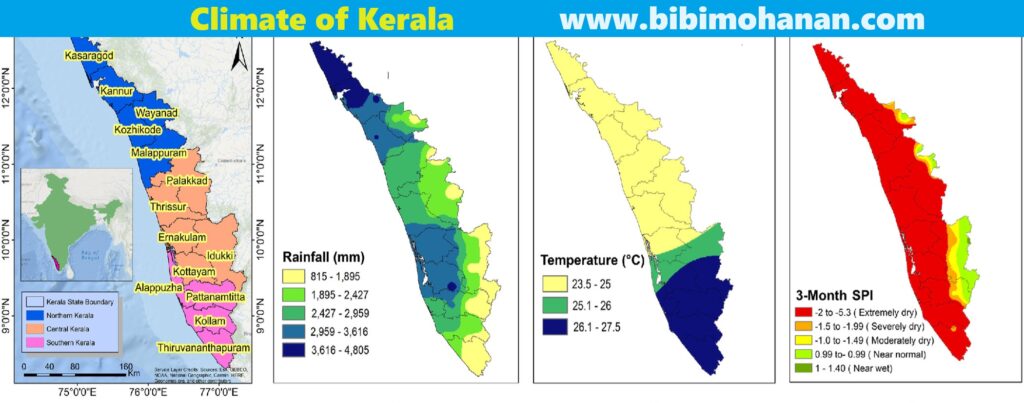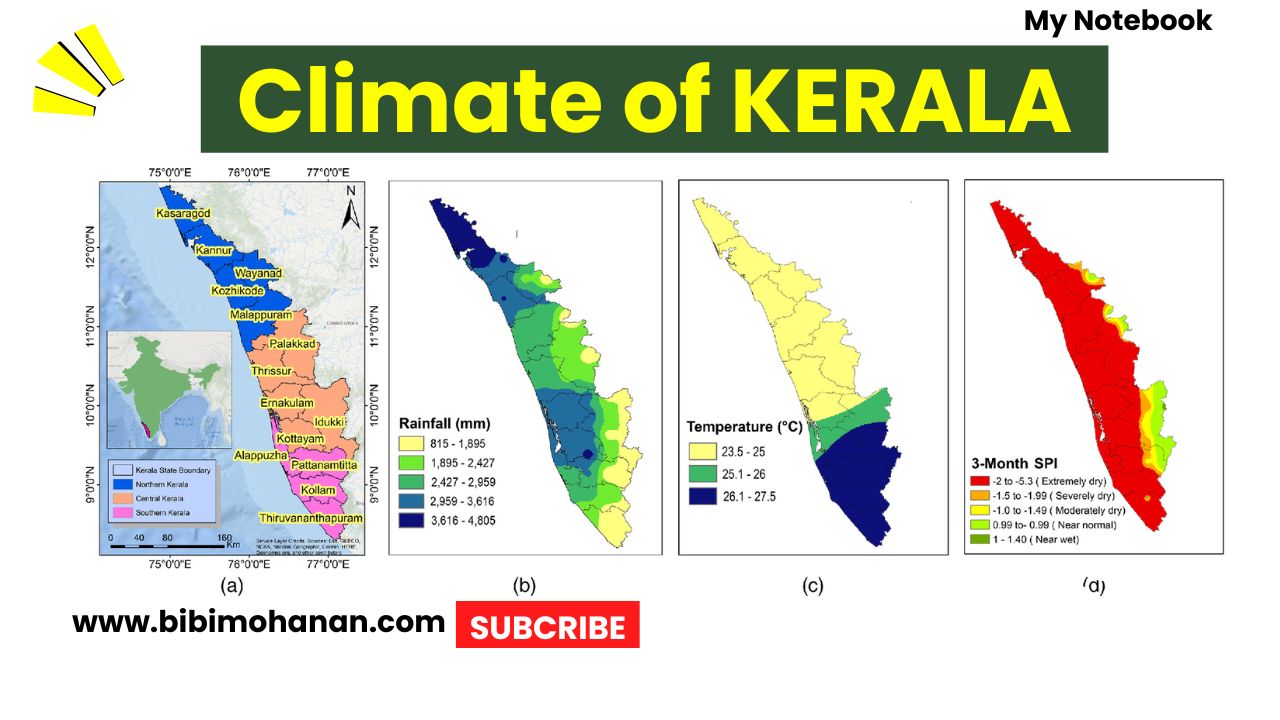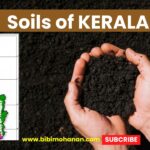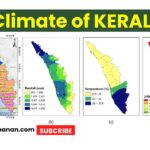Climate of Kerala: As per Koppens classification, climate of Kerala is tropical monsoon.
Geographially Kerala lies proximate to the equator. But in contrast to the equa- torial climate Kerala experience a pleas- ant climate.
But existence of the Western Ghats, influence of the Arabian sea and the pas- sage of the rain bearing monsoon wind makes Kerala a better place to live in.
Climate of Kerala
- The southwest monsoon reaches India in the month of June.
- Kerala is the first state to receive mon- soon showers.
- Monsoon wind was discovered by Hip- palus, a Greek traveller.
- Any variation in the monsoon negative- ly effects the climate of Kerala and its economy.
- Almost all rivers of Kerala are fed by Monsoon showers.
- Agriculture in Kerala is dependent on monsoon.
- The average rainfall of Kerala is 3107 mm.
- The Mean daily temparature of Kerala ranges between – 19.8 to 36.7 degree Celsius.
- Mean annual temparature of Kerala ranges from 25 to 27.5 degree Celsius
- January is the month, which receive the least rainfall in Kerala.
- Neriamangalam in Ernakulam district records the highest rainfall.
- Chinnar in Idukki experience the least rainfall.
- The district in Kerala which receive the highest rainfall is Kozhikode and that of the least is Trivandrum.
- Lakkidi in wayanad is known as Chira- punji of kerala.
- Rain shadow region in kerala is Chin- nar in Idukki.
- The hottest district in Kerala is Palakkad
- The hottest town in Kerala is Punalur.

Seasons in Kerala
There are 4 seasons in Kerala
- Winter season (January to February)
- Summer season (March to May)
- South west Monsoon (June to September)
- North east Monsoon (October to December)
- Kerala is located in the Torrid zone or the tropical region of the earth.
- Meteriological centre at Trivandrum was established by Swathi Thirunal
Winter season
- It starts when North-East monsoon ends
- In the high land temperature falls be- low 10°C.
- Winter season of Kerala spans from mid
- November till December
- Winter season is the driest season of Kerala with an average rainfall of just mm.9 251
- January is the driest month of Kerala with an average rainfall of 3cm
- The maximum temperature during winter is 28°C and the minimum 18°C.
Summer Season
- Summer is experienced in Kerala from March to May.
- The characteristics of summer in Kerala
- are relatively higher temperature, loss rain fall & humid weather Another important feature is eratic rains accompanied by thunder and lightening
- Pre-monsoon summer rains of Kerala is known as Mango Shower
- Atmospheric temperature in Palakkad and Punalur rises to more than 40°C during the summer.
- This is because of the hot wind that blows from the east through the Pala- ghat gap.
- An average of 40 cm rainfall occures during the summer season. (ഇടവപ്പാതി)
South-West Monsoon season
- The rainy season in Kerala is S-W monsoon
- This season is called Edavapathi in Malayalam
- It spans from June to September
- Kerala is the first state to get hit by the monsoon winds as it lies on the windward side of western ghats
- This monsoon provideds 85% of the rains
- Average temperature during this season .Maximum: 30°C. Minimum: 19°C
- Average rainfall during the season 2250-2500 mm
North-East Monsoon
- North-East Monsoon or the retreat ing monsoon rains are received in the months of October and November, and at times continues upto December.(Thulavarsham)
- An average rain 450-500 mm
- North-East Monsoon is also known as Thulavarsham in Malayalam
- Heavy afternoon rains accompanied by thunder and lighteningis the character- istic feature of Thulavarsham.
- The days are warm and humid
- Average temperature Maximum: 35°C, & humidity 29%
- Kerala receive the highest rainfall in the month of July and the least rainfall in January.
- Neriyamangalam in Eranakulam dis- trict is the place in Kerala which receive the highest rainfall in a year.
- Chinnar is the only rain shadow region of Kerala.
- Heavy Floods occurred in 1924 was known as ‘floods of 99’ since the cor- responding year of 1924 in Kollam era was 1099.
- The Next Heavy flood in Kerala was in 2018
- The district that receive maximum rain- fall in Kerala is kozhikode.
- District that receive least rainfall in Ker- ala is Thiruvananthapuram.
- ottest district of Kerala is Palakkad.
Kerala Disaster Management Authority
- On 23rd December 2005, the Government of India enacted the Disaster Management Act, which envisaged the creation of the National Disaster Management Authority (NDMA), headed by the Prime Minister, and State Disas- ter Management Authorities (SDMAs) headed by respective Chief Ministers, to spearhead and implement a holistic and integrated approach to Disaster Management in India.
- Kerala has become the first state to have a Disaster Management Authority.
- The Kerala Disaster Management Authority was formed as stipulated in the National Disaster Management Authority Act of 2005 with the Chief Minister as chairman and the Revenue Minister as Vice-Chairman.
- It has an advisory and an executive committee. Formulation of a state policy, identification of disaster prone areas and planning of disaster management programmes incorporating the services of various departments will come un- der the purview of the state executive commit- tee.
Join Telegram Channel for Study Notes




